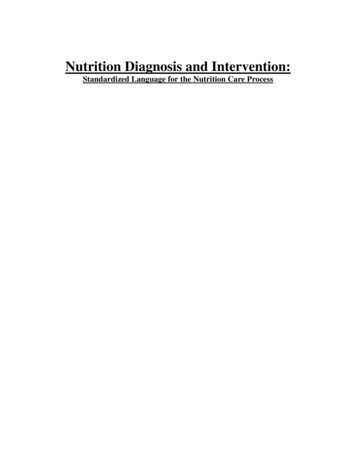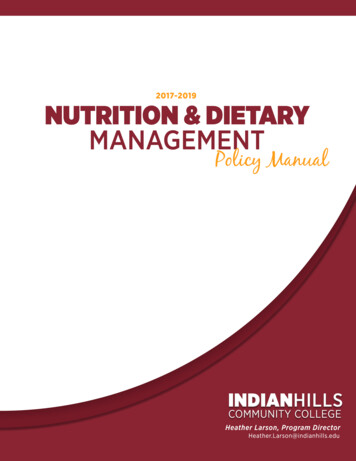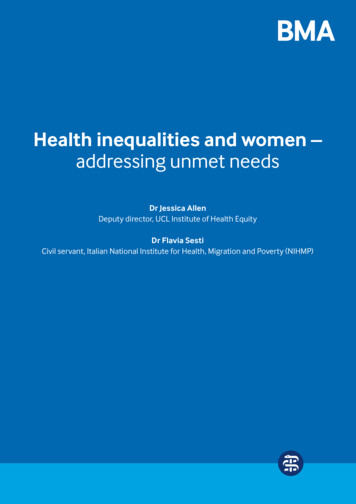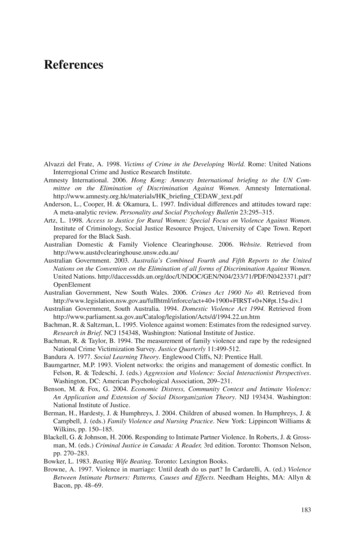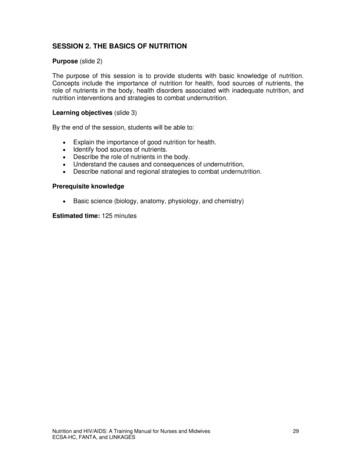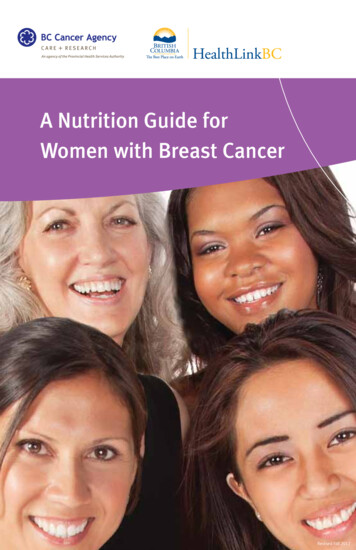
Transcription
A Nutrition Guide forWomen with Breast CancerRevised Fall 2012
AcknowledgementsAppreciation is expressed to the women from across Canada who participated ininterviews and focus groups to plan and field-test this booklet. From the start,it was their questions and ideas that shaped the booklet.Developed by: BC Cancer Agencywww.bccancer.bc.caHealthLink BCwww.HealthLinkBC.caThis publication was created with the support of the Canadian Cancer Society,BC and Yukon Division. This revision was adapted from Nutrition and BreastCancer: What You Need to Know. Canadian Cancer Society 2004.A Nutrition Guide for Women with Breast CancerISBN-10 1-896624-23-5ISBN-13 978-1-896624-23-5 2012 BC Cancer AgencyRevised November 2012The material in this publication may be copied or reproduced without permissionusing the following citation: A Nutrition Guide for Women with Breast Cancer.This booklet contains general information and is not intended to replace the adviceof a qualified healthcare provider.This guide is available at your local cancer centre and www.bccancer.bc.ca(select Patient/Public Info, then Pamphlets/Handouts, then Nutrition)A Nutrition Guide for Women with Breast Cancer
TABLE OF CONTENTS22IntroductionFor more information33After DiagnosisFeelings about food4445Recent EvidenceBody weight: why is body weight important?Low-fat dietExercise666Getting StartedMaintaining a healthy body weightWhat is a healthy weight?1111121419222728Planning A Healthy DietPlant-based dietTips to eating a plant-based dietEating Well with Canada’s Food GuideLow-fat eatingTips to eating a low-fat dietPhysical activityCanadian Physical Activity Guidelines30Frequently Asked Questions4040Eating During TreatmentYour nutritional needs48Complementary Therapies49Natural health products51Complementary diets51When considering nutritional complementary therapies53 Recommended websites for complementary therapies5454555556Further ResourcesCookbooks on healthy eatingHow to find a registered dietitianTelephone servicesRecommended websites586064Appendix A: Food Sources of Common NutrientsAppendix B: Fat Content of Common FoodsAppendix C: Fibre Content of Common FoodsA Nutrition Guide for Women with Breast Cancer
INTRODUCTION“I want to do something for myself.” This statement is being made bythousands of Canadian women with breast cancer. For some of these women,diet is that “something”. Many women believe that understanding nutritionand making good food choices is an important step in their recovery and forlowering the risk of breast cancer recurrence.This booklet focuses on the period after diagnosis and provides women withinformation on lifestyle factors that may: lower the risk of breast cancer recurrence improve survival benefit overall healthIt also includes up-to-date information on: nutrition during treatment that may help with side effects complementary therapies helpful books, websites and other resourcesFor more informationThe information in this booklet answers questions on nutrition asked bywomen who have had breast cancer. If you still have questions after readingthe booklet: discuss them with the staff at your treatment centre call a dietitian at HealthLink BC(dial 8-1-1 for residents of British Columbia) call one of the Canadian Cancer Society’s Information Specialists(toll-free at 1 888 939-3333)2A Nutrition Guide for Women with Breast Cancer
AFTER DIAGNOSISWomen say that the time following the diagnosis of breast cancer is an intenseperiod of learning. Part of this learning may be about food choices.Many women use the time of diagnosis to make lifestyle changes, such aseating healthier and being more active. Some women say it is the perfecttime to make lifestyle changes, while other women find it easiest to keep thechanges small and focus on their recovery. The important thing is for eachwoman to do what is best for herself.Feelings about food“When I first found out I had breast cancer, I asked my surgeon,“Is it my diet that caused this?”Many women question their diet when they learn they have breast cancer.Wanting to know what causes cancer is a natural reaction. However, it isimportant to remember that cancer is a complex disease. It is probably causedby a combination of factors, not just one factor. The risk of developing breastcancer is increased by being overweight or obese, and by alcoholconsumption. The role of a diet high in fat is unclear but may be related.However, women who eat healthy diets can also develop breast cancer.“Since I’ve been diagnosed, I haven’t been able to read or talk about breastcancer, including all the stuff about diet. If I don’t think about cancer,I almost feel that I don’t have it.”Some women may feel this way while others look for information right away.Every woman has a different way of coping with the diagnosis of breastcancer. You will know when you are ready for more information.“I don’t know what to eat now that I have breast cancer. And I’m getting allkinds of advice – drink carrot juice, don’t eat any sugar, eat tofu. I’m reallyconfused.”It is natural to be confused by the many choices now facing you. This bookletmay help answer some of your questions.A Nutrition Guide for Women with Breast Cancer3
RECENT EVIDENCELifestyle factors in breast cancer recurrence and survivalRecent research findings show that factors such as body weight, diet andexercise likely play a role in breast cancer recurrence and survival. Aside fromcancer treatment, lifestyle choices may have the greatest impact on reducingthe risk of breast cancer recurrence and improving overall health. The goodnews is that these are factors you can change.Body weight: why is body weight important?Research tells us that there is a higher risk of breast cancer recurrence as wellas lower overall survival for women who are either overweight, obese or whogain significant weight after the diagnosis of breast cancer. Achieving andmaintaining a healthy body weight may be one of the most important waysfor you to reduce your risk of breast cancer recurrence, improve survivaland improve overall health.This booklet includes tools to help you assess your body weight and providesnutrition tips and strategies for achieving a healthy body weight.Low-fat dietSome research has found a link between a low-fat diet and breast cancer,however not all studies have shown a benefit. In the Women’s InterventionNutrition Study (WINS) a low-fat diet providing 20% of calories from fatlowered the risk of breast cancer recurrence. In this study women wereoverweight and over a period of 5 years lost weight while following thelow-fat diet. These findings suggest that both weight loss and a low-fat dietare important in lowering the risk of breast cancer recurrence.Eating less fat can have many other health benefits. A low-fat diet may alsolower the risk of heart disease and may help achieve weight loss.If you are at a healthy body weight: A low-fat diet is recommended for maintaining a healthy weight.If you need to lose weight: Achieve a healthy body weight by following a low-fat diet.The following sections include tips on a low-fat diet and how to determineyour daily fat goal.4A Nutrition Guide for Women with Breast Cancer
ExerciseExercise may also improve breast cancer survival. Early research shows thatwomen who participate in moderate physical activity such as walking 3–5hours per week improve their survival from breast cancer. Regular physicalactivity can also help prevent weight gain and achieve a healthy body weight ifyou are overweight or have gained weight after the diagnosis of breast cancer.Staying physically active has many health benefits for women with breastcancer. Exercise can improve common side effects of cancer treatmentsuch as fatigue and aid in the prevention and management of lymphedema(arm swelling). Over the long term, exercise can also help preventosteoporosis by minimizing bone loss associated with some treatments.What you need to knowMany of the healthy eating habits that may reduce the risk ofbreast cancer recurrence and improve survival also help overallhealth. The most important lifestyle recommendation after abreast cancer diagnosis is to achieve and maintain a healthybody weight by making gradual changes to the way you eatand by becoming more physically active.Women with breast cancer are recommended to: achieve a healthy body weight defined as a Body Mass Index(BMI) between 18.5–24.9 eat a diet based on Canada’s Food Guide that is lower in fatand high in vegetables, fruit and whole grains be physically active, for example, walk 3–5 hours per weekA Nutrition Guide for Women with Breast Cancer5
GETTING STARTEDThis section provides practical information on food choices and lifestyle habitsto lower your risk of recurrence and improve overall health. Making changesto your lifestyle is very individual. After the diagnosis of breast cancer somewomen may find it is the right time and make changes easily, while otherwomen may find it easier to make smaller, more gradual changes. Keep inmind that any amount of positive change in lifestyle habits is likely to offerhealth benefits.Maintaining a healthy body weightAchieving and maintaining a healthy body weight is important for women whohave been diagnosed with breast cancer for several reasons. A healthy weightmay decrease the risk of breast cancer recurrence and improve survival, andit benefits overall health by decreasing the risk of common health conditionssuch as heart disease, diabetes and other new cancers.What is a healthy weight?A healthy weight is defined as a Body Mass Index (BMI) in the range of18.5–24.9. It is calculated based on your height and weight. The chart belowshows the BMI ranges that are considered underweight, normal, overweightor obese. This applies to everyone between the ages of 18 and 64 years. Forpersons 65 years and older the ‘normal’ range may be slightly above BMI 18.5and extend into the ‘overweight’ range.Body Mass Index (BMI) classificationsBMI category (kg/m2)Classification 18.518.5–24.925.0–29.9 30.0UnderweightNormal weightOverweightObeseRisk of developinghealth problemsIncreasedLeastIncreasedHighAdapted from: Canadian Guidelines for Body Weight Classification in Adults – Quick Reference Tool forProfessionals, Health Canada (2003).6A Nutrition Guide for Women with Breast Cancer
There are health risks with a BMI below 18.5 or above 25.0.If you are overweight or obese, you are at higher risk of developing varioushealth problems including: some types of cancer Type 2 diabetes heart disease high cholesterol insulin resistance gallbladder disease high blood pressure osteoarthritisWhat you need to knowIf your Body Mass Index (BMI) is more than 25.0 and/or yourwaist circumference is greater than 88 cm (35 in) then weightloss is recommended. A safe and healthy rate of weight loss isgradual in the range of 1-2 lbs (0.5-1 kg) per week.The most effective way to lose weight is to create a calorie(energy) deficit using a combination of a calorie-reduced dietplus exercise. See “Tips to help you manage calories”. Settinggoals and keeping a diary are proven methods to increasesuccess with eating healthier or losing weight.Maintaining a healthy body weight after losing weight canbe as difficult as losing the weight itself. Having support andmonitoring your progress is recommended to avoid regainingthe weight you have lost.A Nutrition Guide for Women with Breast Cancer7
Am I at a healthy body weight?To determine if you are at a healthy body weight use the graph below.On the graph, locate the point where your height and weight intersect. Readthe number on the dashed line closest to this point. For example if you weigh65 kg (about 143 lbs) and are 165 cm (about 5’ 5”) you have a BMI ofapproximately 24 which is within the normal range.Height 120264115110504810525346442424042100Weight 40145Weight (lb)5788150155160165170175180185190195200205Height (cm)Source: Canadian Guidelines for Body Weight Classification in Adults – Quick Reference Tool for Professionals,Health Canada (2003). Adapted and reproduced with permission of the Minister of Public Works andGovernment Services Canada, 2009.Health Canada’s website also has a tool to calculate BMI.Visit www.healthcanada.gc.ca and enter “BMI” in the search field.8A Nutrition Guide for Women with Breast Cancer
Waist circumferenceWaist circumference is also used in combination with Body Mass Index (BMI)to determine health risk. Being “apple-shaped” with too much weight aroundthe waistline is associated with similar health problems as being overweight.Being “pear-shaped” with more weight distributed on the hips and thighs isnot a health risk. Overall it is recommended to have a waist circumferenceless than 88 cm (35 in) for women.How do I lose weight if I need to?Slow, steady weight loss is recommended to achieve a healthy body weight.A safe and healthy rate of weight loss is gradual in the range of 1–2 lbs(0.5–1 kg) per week. For example, it would take 2–5 months to safely loseabout 9 kg (20 lbs).Most effective way to lose weightThe most effective way to lose weight is to create a calorie (energy) deficitusing a combination of a calorie-reduced diet plus exercise. See Estimatingyour daily calorie needs (page 21), which outlines estimated calorie needs formaintenance of a healthy body weight. Adding exercise will help you achieveand maintain weight loss and has many other health benefits.Tips to help you manage your calories Eat a low-fat diet rich in vegetables, fruits and whole grains. Choose sensible portion sizes. You might already be eating the right foods,but it could be that you’re eating too much. Occasionally measure theamount of food you serve yourself, and pay special attention to highercalorie foods such as high fat meats, fried foods, desserts and added fats. Limit the amount of liquid calories from pop, coffee beverages andsweetened drinks like iced tea and fruit-flavoured drinks. Love everything you eat. Make sure that when you do indulge in a treat thatit’s worthy of the calories.A Nutrition Guide for Women with Breast Cancer9
Tracking your progressSetting goals and keeping a diary are proven methods to increase successwith eating healthier (such as increasing your intake of fruits and vegetables)or losing weight. A diary or journal is useful for tracking your progress as youmake changes to your diet and learn new behaviours. It involves writing downor using online tools to keep track of everything you eat and drink daily or onselect days. This can help you see if you are on track to reach your goal(s) andif you need to make any adjustments to your plan. You may also choose tokeep track of your physical activity for similar reasons.Preventing weight gainStaying at a healthy weight is just as important as getting there. And, in thelong run it may be easier to try and prevent weight gain than to try and loseit. Some women who are at a healthy weight may notice that their weight hasbeen increasing over the years, particularly during menopause or since thediagnosis of breast cancer or its treatment. This slow gradual weight gain overtime can move us from a healthy weight to overweight. A Body Mass Index(BMI) within the range of 18.5 to 24.9 is considered healthy, but there arehealth risks including an increased risk of breast cancer recurrence associatedwith being overweight (BMI 25.0 to 29.9) or obese (BMI 30.0). Following thetips in this section and in “Planning a Healthy Diet” and keeping physicallyactive can help you maintain your weight and prevent weight gain.Maintaining weight lossMaintaining a healthy body weight after losing weight can be as difficult aslosing the weight itself. Long-term commitment to a healthy eating programand regular exercise is necessary for losing and maintaining weight. Somepeople may find support groups of value, while others may prefer the servicesof a dietitian or doctor, or support from family or friends. In all cases, havingsupport and some way to monitor your progress is recommended to avoidregaining the weight you have lost.10A Nutrition Guide for Women with Breast Cancer
PLANNING A HEALTHY DIETWomen are recommended to use Eating Well with Canada’s Food Guide toplan a plant-based diet. A plant-based diet emphasizes whole grains, fruits,vegetables, beans and lentils. This diet is rich in fibre, vitamins and dietarycompounds referred to as “phytochemicals” or plant nutrients that reduce therisk of developing cancer. Most plant foods are also naturally low in caloriesand fat which can be helpful for managing weight. A plant-based diet doesnot mean that foods from animals need to be eliminated. Compared to atypical Western diet, a plant-based diet can include dairy products and meat,fish and poultry but less often and in smaller portions.Plant-based dietWhen following a plant-based diet within Canada’s Food Guide, aim for 7-8servings of fruit and vegetables, 6-7 servings of grain products and considerchoosing beans and lentils as one of the 2 servings recommended from theMeat and Alternatives food group.What you need to knowA plant-based diet emphasizes whole grains and legumes(beans, lentils and dried peas), vegetables and fruit. Thesefoods provide fibre, vitamins and minerals as well as cancerfighting phytochemicals. Most plant foods are also naturallylow in calories and fat which can be helpful for managingweight.Eat mostly plant foods. Choose foods that are minimallyprocessed.Aim to make at least half of your grain choices wholegrains each day.Choose beans, lentils and dried peas often instead of meat.A Nutrition Guide for Women with Breast Cancer11
Tips to eating a plant-based dietMaking the move towards a plant-based diet will likely involve shopping forand trying new foods and cooking methods. Keep an open mind to try newingredients, flavourful ethnic foods and interesting restaurants while havingfun along the way. Consider following these three steps to enjoy moreplant foods: Reduce your portions of animal foods and include more plant-based foods.Make vegetables, whole grains and legumes the focus of your meal andanimal food the side dish. Introduce beans and lentils into your diet. Start by adding small amountsinto your favourite recipes and increase the proportion gradually whiledecreasing the meat ingredients. Go meatless on occasion. Try a vegetarian meal once a week and graduallyincrease the frequency working towards a whole day without animal foods.What are whole grains?Grains are seeds of plants. There are many types of grains, such as wheat,rice, oats, barely, corn, rye, quinoa and buckwheat. All of these can be eitherwhole or refined depending on how the grain is processed after harvesting.If the whole seed is left intact it is referred to as a whole grain whereas if it isprocessed whereby part of the seed is removed it is a refined grain.Foods rich in whole grainsChoose naturally occurring whole grains (such as oats, corn, brown or wildrice) or foods made from whole grains (such as various forms of breads,cereals, pasta) as part of your daily diet. These foods provide a good sourceof vitamins, minerals and fibre and have a number of health benefits.Some foods that are a rich source of whole grains* are: Cereals made with whole grains such as oats Many types of rice such as brown rice, wild rice Breads, bagels, English muffins and tortillas made with any of the wholegrains listed above, or with whole wheat flour Pastas made with whole grains Corn and popcorn* In Canada, whole wheat flour has a small amount of the seed removed and is therefore technically not awhole grain. Whole wheat flour (and foods made with whole wheat flour, such as many breads) however remaina nutritious choice. In comparison if “whole grain wheat flour” (rather than “whole wheat flour”) is included inthe ingredient list it is by definition a whole grain.12A Nutrition Guide for Women with Breast Cancer
Beans, lentils and dried peasBeans, lentils and dried peas come from a type of plant called legumes. Thereare many different types of beans and lentils which vary in colour, shape andflavor. Common types include kidney beans, black beans and navy beans andgreen, brown, yellow and orange lentils. Soybean, which is used to make tofu,is another type of legume. Chickpeas (or garbanzo beans) and split peas arecommonly used dried peas.Beans, lentils and dried peas are a nutritious and versatile alternative to meat.In addition to providing a low fat source of protein, they provide fibre as wellas B vitamins, iron and cancer fighting phytochemicals.Most legumes are minimally processed. They are sold as dried, canned andsometimes frozen. Dried beans need to soak before cooking, so use themwhen you have the time. Canned beans are easy and quick, but should berinsed to remove excess sodium or purchase no sodium added varieties.Lentils don’t require soaking and cook faster than most beans.Interesting ways to try beans: Use beans in a breakfast burrito or wrap Top a salad with kidney beans and/or chickpeas Dip vegetables into hummus or use hummus as a sandwich filling Make a vegetarian chili with kidney beans, black beans and chickpeas Replace part of the meat in a spaghetti sauce with lentils or tofu Add beans or lentils to soupsA Nutrition Guide for Women with Breast Cancer13
Eating Well with Canada’s Food GuideCanada’s Food Guide outlines the number of servings from each of the fourgroups, based on gender and age. This plan is flexible, offers a wide range ofchoices within each food group and can easily be used by women who choosea low-fat or a vegetarian diet.Choosing the amount and type of food recommended and following the tipsin Canada’s Food Guide will help: meet your needs for vitamins, minerals and other nutrients reduce your risk of obesity, Type 2 diabetes, heart disease, certain types ofcancer and osteoporosis contribute to your overall health and vitalityEating Well with Canada’s Food Guide provides specific advice for women atdifferent ages and stages: The need for vitamin D increases after the age of 50. In addition to followingCanada’s Food Guide, everyone over the age of 50 should take a dailyvitamin D supplement of 400 IU. All women who could become pregnant and those who are pregnant orbreastfeeding need a multivitamin containing folic acid every day. Pregnantwomen need to ensure that their multivitamin also contains iron. Pregnant and breastfeeding women need more calories. Include an extra2 to 3 Food Guide Servings each day (Source: Eating Well with Canada’sFood Guide, Health Canada, 2007).By selecting the recommended servings, you can meet your nutritional needsfor important nutrients such as calcium, iron and fibre. Canada’s Food Guideprovides suggestions for eating healthy, for example: choose vegetables and fruit prepared with little or no added fat choose grain products that are lower in fat select lean meatsIt is important to remember that some fat is healthy. Eating Well with Canada’sFood Guide recommends including a small amount – 30–45 mL (2–3 tbsp) –of unsaturated fats each day. This includes oil used for cooking, saladdressings, margarine and mayonnaise. Vegetable oils such as canola, oliveand soybean or soft margarines are low in saturated and trans fats. Thisamount of added fat is suggested for overall good health.14A Nutrition Guide for Women with Breast Cancer
A Nutrition Guide for Women with Breast Cancer15
16A Nutrition Guide for Women with Breast Cancer
A Nutrition Guide for Women with Breast Cancer17
18A Nutrition Guide for Women with Breast Cancer
Low-fat eatingA healthy diet can include a range of fat levels from 20 to 35% of totalcalories. For breast cancer survivors some research shows that a diet lowerin fat may reduce the risk of cancer recurrence (see page 4). While ongoingdebate continues on what the ideal fat intake is for women with a history ofbreast cancer aiming for a fat intake in the lower range may have advantages.A lower fat diet may also help women to achieve weight loss and has beenshown to be beneficial in the prevention and treatment of heart disease.When following a low-fat diet it is important to focus on both the total amountand quality (type) of fat you eat. Choosing fats found in plant-based foodssuch as nuts, seeds, avocados and vegetable oils is preferred to saturatedfat from animals. When eating a low-fat diet, it is also important to focus onreplacing fat with foods that are minimally processed or refined. This includeschoosing whole grains, beans, lentils and fruits and vegetables rather thanprocessed and refined foods such as white breads, baked goods andsugary foods.What you need to knowWomen are recommended to follow a plant-based diet that islower in fat. While a healthy diet can include a wide range of fatintakes, evidence shows what women with breast cancer canreduce their risk of recurrence by following a low-fat diet thatprovides 20% of total calories from fat. This diet may also bebeneficial in helping to achieve or maintain weight loss and inlowering the risk of heart disease.Replacing fat with nutrient-rich foods such as whole grains,beans, lentils and fruits and vegetables will provide thegreatest health benefits. Avoid replacing fat with refined,processed foods (such as white breads or cereals, bakedgoods) or high sugar foods (such as soft drinks).A Nutrition Guide for Women with Breast Cancer19
How much fat can I eat?The amount of total fat you should eat depends on how many calories youneed each day. This is because fat intake is based on a percentage of the totalcalories you eat. Most women need an estimated 1600–2000 calories perday. Based on this calorie range the amount of fat recommended on a low-fatdiet that contains 20% of calories from fat is about 35–45 g per day. This totalincludes both the fat within foods, such as meat, cheese and nuts and the fatadded in cooking and at the table. Added all together, it equals approximately45-55 ml (9–11 tsp) of fat per day. See Appendix B: Fat Content of CommonFoods for the grams of fat in individual foods.For simplicity you can use 35–45 g of fat per day as a goal (based onapproximately 1600–2000 calories per day). You can also use the twocharts below to estimate your individual calorie and fat goals. To determine your daily calorie needs, find your age and activity level fromthe first chart, Estimating your calorie needs. For example, if you are 45 yearsold and have a “moderate” activity level, your calories needs are2000 per day. Next, use the second chart, Daily dietary fat goals, to identify the amount offat you are recommended to eat based on your daily calorie needs.These values are based on women who are maintaining their weight. If youneed to gain or lose weight, you will need to adjust your estimated dailycalorie needs either up or down.20A Nutrition Guide for Women with Breast Cancer
Estimating your daily calorie needsPhysical activity levelAge19–30 yrs31–50 yrs51–70 yrs71 yrs and olderLightModerateActiveTypical daily living activities(for example, householdtasks, walking to the bus).Typical daily living activitiesplus 30–60 minutes of dailymoderate activity (forexample, walking at5–7 km/h).Typical daily living activitiesplus at least 60 minutes ofdaily moderate activity (forexample, walking at5–7 km/h).1900 calories1800 calories1650 calories1550 calories2100 calories2000 calories1850 calories1750 calories2350 calories2250 calories2100 calories2000 caloriesAdapted from: Health Canada www.healthcanada.gc.ca. These values are based on average needs.To calculate your individual estimated energy requirement visit HealthCanada’s website at www.healthcanada.gc.ca and enter “estimating energyrequirements” in the search field.Daily dietary fat goalsThis chart lists the number of grams of fat that equals 20%, 25% and 30%calories from fat for each of the calorie levels listed in the table above.Calorie goalper day1550165017501800185019002000210022502350Fat (grams per day)20%of total calories3437394041424447505225%of total calories4346495051535658636530%of total calories52555860626367707578A Nutrition Guide for Women with Breast Cancer21
Tips to eating a low-fat dietPrepare foods in ways that use less fatUse steaming, poaching, baking or broiling instead of frying.Try lower-fat recipesSubstitute lower fat ingredients in your favourite recipes, or try some newlower-fat recipes. Today’s low-fat cookbooks describe many ways to cookusing little or no fat. These books provide lower fat recipes for manytraditional dishes. Most of them also have a section at the beginningexplaining how to eat less fat. See Cookbooks on healthy eating.Limit the amount of fat that you add to foodInstead of . butter on a baked potato margarine on toast butter on cooked vegetables mayonnaise on a sandwich cream in coffee or tea regular salad dressing cream sauce for pastaTry . light sour cream, plain yogurt or salsa jam or honey lemon, garlic and/or herbs mustard, chutney or cranberry sauce skim or low-fat milk low-fat or fat-free dressing tomato-vegetable sauceChoose lower-fat foods Choose 1% or skim milk Choose lower fat or fat-free yogurt Choose lower fat cheeses (look for the percentage of milk fat [%MF] on thelabel and choose those with less than 20% [MF] milk fat) Choose lean meats, such as sirloin, loin, round, rump and extra lean groundbeef, and trim off the visible fat. Limit processed meats such as bologna,wieners, bacon, sausages and pepperoni Remove the skin from poultryShop for lower fat foodsLimit foods that are processed with added fat. For example, breaded fishsticks contain added fat while fresh fish fillets do not. Also, French fries andpotato chips contain added fat
helpful books, websites and other resources For more information The information in this booklet answers questions on nutrition asked by women who have had breast cancer. If you still have questions after reading the booklet: discuss them with the staff at your treatment centre call a dietitian at HealthLink BC





